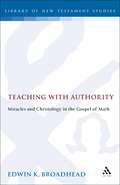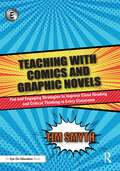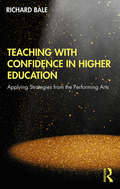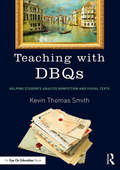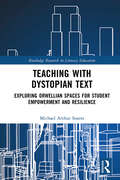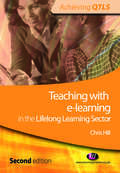- Table View
- List View
Teaching Well with Adolescent Learners: Responding to Developmental Changes in Middle School and High School
by David Strahan Jeanneine Jones Madison WhiteThis concise and accessible book, co-published with the Association for Middle Level Education (AMLE), offers pre-service and in-service middle school and high school educators a way to integrate an understanding of adolescent development with strong pedagogical applications for their students. Blending contemporary research on adolescent development with authentic teachers’ voices, the authors demonstrate methods for how to successfully observe, understand, engage, and teach adolescent students, particularly around the developmental changes that occur from ages 11 to 15 (grades six through ten). The book features real-world classroom narratives that illustrate the successes—and struggles—of everyday teachers, and details specific teaching practices, classroom activities, and lesson ideas that help teachers tap into the energy and talents that adolescent students bring to the classroom. Featuring narrative case studies from teachers in the field, this practical book will be of value to middle and high school educators looking at how the physical and emotional changes experienced by students during adolescence impact their learning. It will also support scholars, practitioners, and students more broadly involved with adolescent development, classroom practice, secondary learning, and equity and inclusion in the classroom.
Teaching What They Learn, Learning What They Live: How Teachers' Personal Histories Shape Their Professional Development
by Brad Olsen"Cogent, interesting, and provocative."-from the foreword by Ann Lieberman Teaching What They Learn, Learning What They Live explores the multiple social, political, and epistemological domains that comprise learning-to-teach. Based on a study of eight beginning English teachers at four different university teacher preparation programs, this book examines the ways in which beginning teachers' personal dispositions and conceptions combines with their teacher preparation programs' professional knowledge and contexts to form their understandings of and approaches toward teaching. Brad Olsen recasts learning-to-teach as a continuous, situated identity process in which prior experiences produce deeply embedded ways of viewing the world that go on to organize current/future experience into meaning. Since experience shapes learning and everyone acquires different sets of experience, no individual teacher's knowledge is exactly like another's. Yet Olsen shows also that the process by which a teacher constructs professional knowledge is common: the what of teacher knowledge varies, but the how remains the same.
Teaching What They Learn, Learning What They Live: How Teachers' Personal Histories Shape Their Professional Development
by Brad Olsen"Cogent, interesting, and provocative."-from the foreword by Ann Lieberman Teaching What They Learn, Learning What They Live explores the multiple social, political, and epistemological domains that comprise learning-to-teach. Based on a study of eight beginning English teachers at four different university teacher preparation programs, this book examines the ways in which beginning teachers' personal dispositions and conceptions combines with their teacher preparation programs' professional knowledge and contexts to form their understandings of and approaches toward teaching. Brad Olsen recasts learning-to-teach as a continuous, situated identity process in which prior experiences produce deeply embedded ways of viewing the world that go on to organize current/future experience into meaning. Since experience shapes learning and everyone acquires different sets of experience, no individual teacher's knowledge is exactly like another's. Yet Olsen shows also that the process by which a teacher constructs professional knowledge is common: the what of teacher knowledge varies, but the how remains the same.
Teaching What You Don’t Know
by Therese HustonYour graduate work was on bacterial evolution, but now you're lecturing to 200 freshmen on primate social life. You've taught Kant for twenty years, but now you're team-teaching a new course on “Ethics and the Internet.” The personality theorist retired and wasn't replaced, so now you, the neuroscientist, have to teach the "Sexual Identity" course. Everyone in academia knows it and no one likes to admit it: faculty often have to teach courses in areas they don't know very well. The challenges are even greater when students don't share your cultural background, lifestyle, or assumptions about how to behave in a classroom. In this practical and funny book, an experienced teaching consultant offers many creative strategies for dealing with typical problems. How can you prepare most efficiently for a new course in a new area? How do you look credible? And what do you do when you don't have a clue how to answer a question? Encouraging faculty to think of themselves as learners rather than as experts, Therese Huston points out that authority in the classroom doesn't come only, or even mostly, from perfect knowledge. She offers tips for introducing new topics in a lively style, for gauging students' understanding, for reaching unresponsive students, for maintaining discussions when they seem to stop dead, and -yes- for dealing with those impossible questions. Original, useful, and hopeful, this book reminds you that teaching what you don't know, to students whom you may not understand, is not just a job. It's an adventure.
Teaching with a Global Perspective: Practical Strategies from Course Design to Assessment
by Dawn Bikowski Talinn PhillipsThis important book answers the growing call for US institutions to internationalize, create global citizens, and better serve diverse populations. Faculty are increasingly tasked with simultaneously encouraging a more inclusive worldview, facilitating classroom environments that harness the potential of students, and advising students who may need an array of university services or speak English as an additional language. Teaching with a Global Perspective is an accessible, hands-on tool for faculty and instructors seeking to facilitate global classroom environments and to offer diverse students the academic, language, and interpersonal support needed for success. Rich with practical features including Classroom Strategies, Assessments, Case studies, Discussion Questions, and suggestions for further reading in bibliographies, chapters address: developing a working understanding of global learning and inclusivity; identifying opportunities and barriers to helping students grow as global citizens; building confidence in teaching with a global perspective; facilitating courses and in-class participation that promote global and inclusive learning and communication between diverse populations; designing curricula, courses, assignments, and assessments that foster global and inclusive learning and support students with varied needs; and providing facilitative responses to students’ academic work. Teaching with a Global Perspective bridges an important divide in discussions about globalizing curricula by developing readers’ content knowledge while also helping them to develop more effective global communication strategies.
Teaching with a Global Perspective: Practical Strategies from Course Design to Assessment
by Dawn Bikowski Talinn PhillipsThis important book answers the growing call for US institutions to internationalize, create global citizens, and better serve diverse populations. Faculty are increasingly tasked with simultaneously encouraging a more inclusive worldview, facilitating classroom environments that harness the potential of students, and advising students who may need an array of university services or speak English as an additional language. Teaching with a Global Perspective is an accessible, hands-on tool for faculty and instructors seeking to facilitate global classroom environments and to offer diverse students the academic, language, and interpersonal support needed for success. Rich with practical features including Classroom Strategies, Assessments, Case studies, Discussion Questions, and suggestions for further reading in bibliographies, chapters address: developing a working understanding of global learning and inclusivity; identifying opportunities and barriers to helping students grow as global citizens; building confidence in teaching with a global perspective; facilitating courses and in-class participation that promote global and inclusive learning and communication between diverse populations; designing curricula, courses, assignments, and assessments that foster global and inclusive learning and support students with varied needs; and providing facilitative responses to students’ academic work. Teaching with a Global Perspective bridges an important divide in discussions about globalizing curricula by developing readers’ content knowledge while also helping them to develop more effective global communication strategies.
Teaching with a Strength-Based Approach: How to Motivate Students and Build Relationships
by Steven BaronHelping students improve doesn't have to mean remediating their deficits. In this important book, Steven Baron shows the benefits of a strength-based approach that instead emphasizes students' assets and capabilities, making them feel more connected to teachers and peers and more engaged in learning. You’ll learn practical, research-backed ways to help students of all grade levels identify and celebrate their strengths, develop self-confidence and a growth mindset, build intrinsic motivation, overcome a fear of making mistakes, manage their feelings, focus on gratitude, and more. You’ll also discover ways to create a more strength-based Individual Education Plan (IEP), increase your own resilience as a teacher, and build a strength-based culture throughout your school and district. The appendix provides a variety of exercises you can use to help students focus on their strengths, foster kindness, and understand the impact of bullying. Students spend approximately 1300 hours during the year with teachers; this resource will help you make this time as affirming as possible so students are ready to learn and grow.
Teaching with a Strength-Based Approach: How to Motivate Students and Build Relationships
by Steven BaronHelping students improve doesn't have to mean remediating their deficits. In this important book, Steven Baron shows the benefits of a strength-based approach that instead emphasizes students' assets and capabilities, making them feel more connected to teachers and peers and more engaged in learning. You’ll learn practical, research-backed ways to help students of all grade levels identify and celebrate their strengths, develop self-confidence and a growth mindset, build intrinsic motivation, overcome a fear of making mistakes, manage their feelings, focus on gratitude, and more. You’ll also discover ways to create a more strength-based Individual Education Plan (IEP), increase your own resilience as a teacher, and build a strength-based culture throughout your school and district. The appendix provides a variety of exercises you can use to help students focus on their strengths, foster kindness, and understand the impact of bullying. Students spend approximately 1300 hours during the year with teachers; this resource will help you make this time as affirming as possible so students are ready to learn and grow.
Teaching with Authority: Miracles and Christology in the Gospel of Mark (The Library of New Testament Studies #74)
by Edwin K. BroadheadThe foundational inquiries into the relationship of miracles and Christology by Wrede, Dibelius, Bultmann and Marxsen guided a productive half-century of critical research. Their work raised crucial issues concerning the nature of the Gospels and the proper methods of interpretation that have in many ways charted the direction for New Testament studies. A new principle is now to be added to their criteria, however, that strategies of interpretation must be consciously shaped to highlight the features of narrative and its christological focus. The author then employs a consistent narrative strategy of interpretation in order to re-evaluate the relation of miracles and Christology in the Gospel of Mark. The primary goal is reconsideration of the role played by miracle stories in the characterization of Jesus. In particular, the tension posed by recent scholarship between the Jesus of the miracles and the Jesus of the cross is shown to be a false dichotomy.
Teaching with Books that Heal: Authentic Literature and Literacy Strategies to Help Children Cope with Everyday Problems
by Patricia L. Kolencik Carianne BernadowskiHelp children learn coping skills through literature! This book answers the often repeated question: Is there a children's book I can read in my classroom to give children insight into significant life events? Literature ideas and activities help students cope with real-life situations, such as bullying, that interfere with school. This book will assist educators in guiding and nurturing children's special issues and concerns with outstanding, ready-to-go reading and writing lessons. This professional resource for K-6 educators and parents uses literature with identifiable characters to help children who are facing challenges in their lives. Like bullying, peer acceptance, peer pressure, and being different, as well as family situations such as death, divorce, adoption, and sibling rivalry.
Teaching with Classroom Response Systems: Creating Active Learning Environments
by Derek BruffThere is a need in the higher education arena for a book that responds to the need for using technology in a classroom of tech-savvy students. This book is filled with illustrative examples of questions and teaching activities that use classroom response systems from a variety of disciplines (with a discipline index). The book also incorporates results from research on the effectiveness of the technology for teaching. Written for instructional designers and re-designers as well as faculty across disciplines. A must-read for anyone interested in interactive teaching and the use of clickers. This book draws on the experiences of countless instructors across a wide range of disciplines to provide both novice and experienced teachers with practical advice on how to make classes more fun and more effective.”--Eric Mazur, Balkanski Professor of Physics and Applied Physics, Harvard University, and author, Peer Instruction: A User’s Manual “Those who come to this book needing practical advice on using ‘clickers’ in the classroom will be richly rewarded: with case studies, a refreshing historical perspective, and much pedagogical ingenuity. Those who seek a deep, thoughtful examination of strategies for active learning will find that here as well—in abundance. Dr. Bruff achieves a marvelous synthesis of the pragmatic and the philosophical that will be useful far beyond the life span of any single technology.” --Gardner Campbell, Director, Academy for Teaching and Learning, and Associate Professor of Literature, Media, and Learning, Honors College, Baylor University
Teaching with Classroom Response Systems: Creating Active Learning Environments
by Derek BruffThere is a need in the higher education arena for a book that responds to the need for using technology in a classroom of tech-savvy students. This book is filled with illustrative examples of questions and teaching activities that use classroom response systems from a variety of disciplines (with a discipline index). The book also incorporates results from research on the effectiveness of the technology for teaching. Written for instructional designers and re-designers as well as faculty across disciplines. A must-read for anyone interested in interactive teaching and the use of clickers. This book draws on the experiences of countless instructors across a wide range of disciplines to provide both novice and experienced teachers with practical advice on how to make classes more fun and more effective.”--Eric Mazur, Balkanski Professor of Physics and Applied Physics, Harvard University, and author, Peer Instruction: A User’s Manual “Those who come to this book needing practical advice on using ‘clickers’ in the classroom will be richly rewarded: with case studies, a refreshing historical perspective, and much pedagogical ingenuity. Those who seek a deep, thoughtful examination of strategies for active learning will find that here as well—in abundance. Dr. Bruff achieves a marvelous synthesis of the pragmatic and the philosophical that will be useful far beyond the life span of any single technology.” --Gardner Campbell, Director, Academy for Teaching and Learning, and Associate Professor of Literature, Media, and Learning, Honors College, Baylor University
Teaching with Comics: Empirical, Analytical, and Professional Experiences
by Robert Aman Lars WallnerThis edited collection analyses the use of comics in primary and secondary education. The editors and contributors draw together global research to examine how comics can be used for critical inquiry within schools, and how they can be used within specific disciplines. As comics are beginning to be recognised more widely as an important resource for teaching, with a huge breadth of topics and styles, this interdisciplinary book unites a variety of research to analyse how learning is 'done' with and through comics. The book will be of interest to educational practitioners and school teachers, as well as students and scholars of comic studies, education and social sciences more broadly.
Teaching with Comics and Graphic Novels: Fun and Engaging Strategies to Improve Close Reading and Critical Thinking in Every Classroom
by Tim Smyth35th Annual Will Eisner Comic Industry Awards Nominee! This text will allow you to harness students’ love of comics and graphic novels while increasing critical thinking and engagement in the classroom. Author Tim Smyth offers a wide variety of lessons and ideas for using comics to teach close reading, working with textual evidence, literature adaptations, symbolism and culture, sequencing, essay writing, and more. He also models how to use comics to tackle tough topics and enhance social-emotional learning. Throughout the book, you’ll find a multitude of practical resources, including a variety of lesson plans—some quick and easy activities as well as more detailed ready-to-use unit plans. These thoughtful lessons meet the Common Core State Standards and are easy to adapt for any subject area or grade level to fit into your curriculum. Add this book to your professional library and you’ll have a new and exciting way of reaching and teaching your students!
Teaching with Comics and Graphic Novels: Fun and Engaging Strategies to Improve Close Reading and Critical Thinking in Every Classroom
by Tim Smyth35th Annual Will Eisner Comic Industry Awards Nominee! This text will allow you to harness students’ love of comics and graphic novels while increasing critical thinking and engagement in the classroom. Author Tim Smyth offers a wide variety of lessons and ideas for using comics to teach close reading, working with textual evidence, literature adaptations, symbolism and culture, sequencing, essay writing, and more. He also models how to use comics to tackle tough topics and enhance social-emotional learning. Throughout the book, you’ll find a multitude of practical resources, including a variety of lesson plans—some quick and easy activities as well as more detailed ready-to-use unit plans. These thoughtful lessons meet the Common Core State Standards and are easy to adapt for any subject area or grade level to fit into your curriculum. Add this book to your professional library and you’ll have a new and exciting way of reaching and teaching your students!
Teaching with Confidence: A Guide to Enhancing Teacher Self-Esteem (PDF)
by Dr Denis Lawrence`The book is an ideal companion for the newly qualified teacher or for colleagues unfamiliar with social psychological concepts and basic communication theory' - ELAN Teaching with Confidence shows how to combat the stress and low self-esteem suffered by many teachers. Denis Lawrence focuses on the relationship between stress and self-esteem, and sets out a programme of easy-to-use everyday strategies to reduce the problem. The author, previously Chief Educational Psychologist for Somerset, has worked with teachers in Somerset, Cornwall and Australia. He has extensive experience of running workshops on the topics of self- esteem enhancement, behavioural difficulties, counselling skills and stress management.
Teaching with Confidence in Higher Education: Applying Strategies from the Performing Arts
by Richard BalePresenting higher education teaching as a performative, creative, and improvisational activity, Teaching with Confidence in Higher Education explores how skills and techniques from the performing arts can be used to increase the confidence and enhance the performance of teachers. Guiding readers to reflect on their own teaching practices, this helpful and innovative book proposes practical techniques that will improve higher education teachers’ abilities to lead and facilitate engaging and interactive learning sessions. Encouraging the creation of inclusive learning experiences, the book offers insights into how performative techniques can help place the student centre stage. Drawing on a variety of performing arts contexts, including acting, singing, stand-up comedy, and dance, as well as interviews with academics and performers, the book helps readers to: Critically analyse their own practice, identifying areas for improvement Manage their anxiety and ‘stage fright’ when it comes to teaching Become more aware of both their voice and body, establishing professional techniques to improve physical and vocal performance Learn to improvise in order to prepare for the unprepared Understand the concepts of active learning and inclusivity within the classroom. Raising awareness of good practice as well as potential areas for development, Teaching with Confidence in Higher Education is ideal for anyone new to teaching in higher education or looking to improve student engagement through the performance aspects of their teaching.
Teaching with Confidence in Higher Education: Applying Strategies from the Performing Arts
by Richard BalePresenting higher education teaching as a performative, creative, and improvisational activity, Teaching with Confidence in Higher Education explores how skills and techniques from the performing arts can be used to increase the confidence and enhance the performance of teachers. Guiding readers to reflect on their own teaching practices, this helpful and innovative book proposes practical techniques that will improve higher education teachers’ abilities to lead and facilitate engaging and interactive learning sessions. Encouraging the creation of inclusive learning experiences, the book offers insights into how performative techniques can help place the student centre stage. Drawing on a variety of performing arts contexts, including acting, singing, stand-up comedy, and dance, as well as interviews with academics and performers, the book helps readers to: Critically analyse their own practice, identifying areas for improvement Manage their anxiety and ‘stage fright’ when it comes to teaching Become more aware of both their voice and body, establishing professional techniques to improve physical and vocal performance Learn to improvise in order to prepare for the unprepared Understand the concepts of active learning and inclusivity within the classroom. Raising awareness of good practice as well as potential areas for development, Teaching with Confidence in Higher Education is ideal for anyone new to teaching in higher education or looking to improve student engagement through the performance aspects of their teaching.
Teaching with DBQs: Helping Students Analyze Nonfiction and Visual Texts
by Kevin Thomas SmithHelp your students navigate complex texts in history and social studies. This book shows you how to use document-based questions, or DBQs, to build student literacy and critical thinking skills while meeting rigorous state standards and preparing students for AP exams. DBQs can be implemented year-round and can be adjusted to meet your instructional needs. With the helpful advice in this book, you’ll learn how to use DBQs to teach nonfiction and visual texts, including primary and secondary sources, maps, and paintings. You’ll also get ideas for teaching students to examine different points of view and write analytical responses. Topics include: Using the SOAPSETone (Speaker, Occasion, Audience, Purpose, Subject, Evidence and Tone) technique to to analyze visual and nonvisual texts; Teaching students to distinguish between primary and secondary sources; Working with multiple texts and learning to recognize the relationships between them; Formulating DBQs to suit different types of assessment, including short-answer questions, multiple-choice questions, and in-class essay prompts; Evaluating student responses and providing constructive feedback.
Teaching with DBQs: Helping Students Analyze Nonfiction and Visual Texts
by Kevin Thomas SmithHelp your students navigate complex texts in history and social studies. This book shows you how to use document-based questions, or DBQs, to build student literacy and critical thinking skills while meeting rigorous state standards and preparing students for AP exams. DBQs can be implemented year-round and can be adjusted to meet your instructional needs. With the helpful advice in this book, you’ll learn how to use DBQs to teach nonfiction and visual texts, including primary and secondary sources, maps, and paintings. You’ll also get ideas for teaching students to examine different points of view and write analytical responses. Topics include: Using the SOAPSETone (Speaker, Occasion, Audience, Purpose, Subject, Evidence and Tone) technique to to analyze visual and nonvisual texts; Teaching students to distinguish between primary and secondary sources; Working with multiple texts and learning to recognize the relationships between them; Formulating DBQs to suit different types of assessment, including short-answer questions, multiple-choice questions, and in-class essay prompts; Evaluating student responses and providing constructive feedback.
Teaching with Dystopian Text: Exploring Orwellian Spaces for Student Empowerment and Resilience (Routledge Research in Literacy Education)
by Michael Arthur SoaresTeaching with Dystopian Text propounds an exchange of spatial to pedagogical practices centered around “Orwellian Spaces,” signaling a new utility for teaching with dystopian texts in secondary education. The volume details the urgency of dystopian texts for secondary students, providing theoretical frameworks, classroom examples and practical research. The function of dystopian texts, such as George Orwell’s 1984, as social and political critique is demonstrated as central to their power. Teaching with Dystopian Text: Exploring Orwellian Spaces for Student Empowerment and Resilience makes a case that dystopian texts can be instrumental in the transfer of spatial practices to pedagogical practices. Pedagogical application creates links between the text and the student through defamiliarization, connecting the student to practices of resistance in the space of the classroom. The volume also addresses the challenges of teaching dystopian text in a dystopian educational climate including the COVID-19 lockdown. In addition to appealing to scholars and researchers of literacy education, language education and dystopian text, this book will also be a powerful yet accessible resource for secondary teachers as they address dystopian concerns with students in the complicated twenty-first century.
Teaching with Dystopian Text: Exploring Orwellian Spaces for Student Empowerment and Resilience (Routledge Research in Literacy Education)
by Michael Arthur SoaresTeaching with Dystopian Text propounds an exchange of spatial to pedagogical practices centered around “Orwellian Spaces,” signaling a new utility for teaching with dystopian texts in secondary education. The volume details the urgency of dystopian texts for secondary students, providing theoretical frameworks, classroom examples and practical research. The function of dystopian texts, such as George Orwell’s 1984, as social and political critique is demonstrated as central to their power. Teaching with Dystopian Text: Exploring Orwellian Spaces for Student Empowerment and Resilience makes a case that dystopian texts can be instrumental in the transfer of spatial practices to pedagogical practices. Pedagogical application creates links between the text and the student through defamiliarization, connecting the student to practices of resistance in the space of the classroom. The volume also addresses the challenges of teaching dystopian text in a dystopian educational climate including the COVID-19 lockdown. In addition to appealing to scholars and researchers of literacy education, language education and dystopian text, this book will also be a powerful yet accessible resource for secondary teachers as they address dystopian concerns with students in the complicated twenty-first century.
Teaching with e-learning in the Lifelong Learning Sector (Achieving QTLS Series)
by Chris HillThis new edition (previously entitled "Teaching Using Information and Learning Technology in Further Education") is an up to date resource for trainee and qualified teachers within the Lifelong Learning Sector. Focusing on information and learning technology as a toolkit for resourceful teachers, it includes reflective activities, teaching strategies and teaching tips throughout, along with ideas for applying these to the reader′s own context. In this new edition, all material has been fully updated to reflect the latest changes in technology and its applications, and each chapter in the book is referenced to the new LLUK Standards.
Teaching with e-learning in the Lifelong Learning Sector (Achieving QTLS Series)
by Chris HillThis new edition (previously entitled "Teaching Using Information and Learning Technology in Further Education") is an up to date resource for trainee and qualified teachers within the Lifelong Learning Sector. Focusing on information and learning technology as a toolkit for resourceful teachers, it includes reflective activities, teaching strategies and teaching tips throughout, along with ideas for applying these to the reader′s own context. In this new edition, all material has been fully updated to reflect the latest changes in technology and its applications, and each chapter in the book is referenced to the new LLUK Standards.
Teaching with Emotional Intelligence: A step-by-step guide for Higher and Further Education professionals
by Alan MortiboysThe way teachers shape and handle their own feelings and those of their learners is central to the success of learning. Now in its second edition, Teaching with Emotional Intelligence shows how to manage this influential yet neglected area of learning and teaching. This practical book looks at how lecturers and teachers can develop and use their emotional intelligence to enhance their teaching and their students’ learning. Taking the reader step-by-step through the learning process and looking at the relationship from the perspective of both the teacher and the learner, this book will help the reader to: plan the emotional environment; learn how to relate and listen to learners effectively; read and respond to the feelings of individuals and groups; handle and reveal their feelings as a teacher, as appropriate; develop self-awareness as a teacher; recognise their prejudices and preferences; improve non-verbal communication; plan for the physical experience of learners; deal with their learners’ expectations, comments and questions. This book contains a number of revised activities, checklists and points for deeper reflection as well as new chapters on teaching with emotional intelligence with international students, in online learning and in working one-to-one with students. It will help all teaching professionals encourage their learners to become more engaged, creative, positive and motivated.





